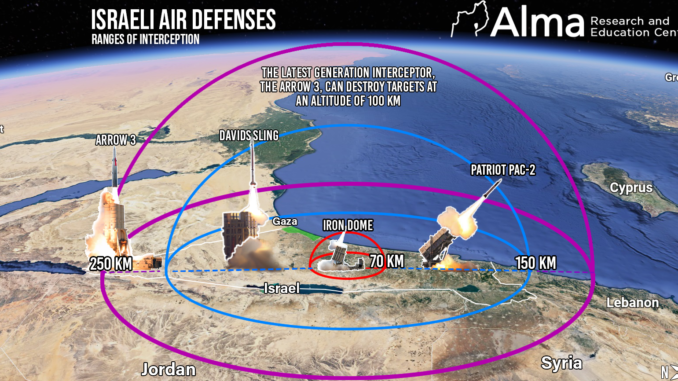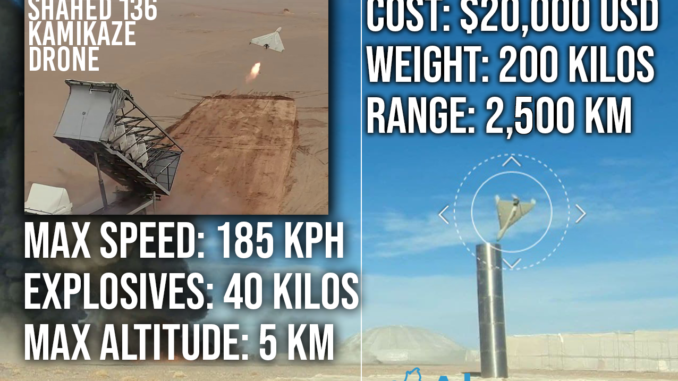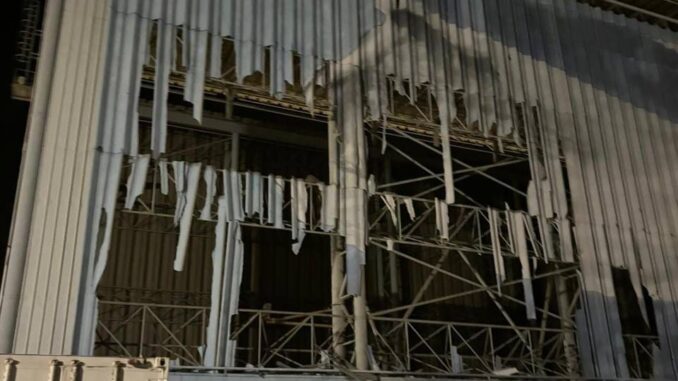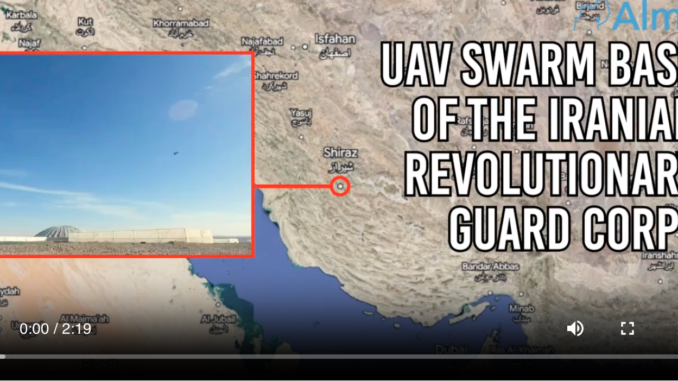By Yaakov Lappin, ALMA EDUCATION AND RESEARCH CENTER 10 April 2024

The threat of a UAV swarm attack, which constitutes a central concept in the battle doctrine of the radical axis led by Iran, poses a significant and evolving challenge to regional stability and security, particularly to Israel. This is especially true in light of Iran’s threat to retaliate for the elimination (on April 1st) of the Quds Force commander in Syria and Lebanon, Mohammad Reza Zahedi (Hasan Mahdavi).
Swarm warfare as a concept is at the heart of the combat doctrine of the Iranian Islamic Revolutionary Guard Corps (IRGC). Over the years, this operational concept has been imparted to Iranian proxies across the Middle East.
At the core of this concept is a simple principle: exploiting numerical superiority to penetrate and overcome various defense layers. This approach is not limited to a single operational domain but instead crosses domains, finding expression in ground, maritime (for example, the attack doctrine of the IRGC’s Navy advocates for striking enemy targets with swarms of boats, including small explosive boats), and aerial attacks, in the form of unmanned aerial vehicle (UAV) swarms, where each swarm formation can be accompanied by heavy barrages of rockets and missiles.
Under this logic, quantity in attack overcomes the quality of defense.
 Image: A swarm of Iranian boats in the Arabian Gulf
Image: A swarm of Iranian boats in the Arabian Gulf
Hamas’s mass murder attack on October 7th from the Gaza Strip demonstrated the multi-domain nature of the threat, with ‘swarms’ of terrorist operatives from Hamas, Palestinian Islamic Jihad (PIJ), and others – about 3000 – overcoming the IDF’s defensive lines and breaching the border barrier at approximately 30 ground points, from the air via powered gliders, and by sea, combined with heavy barrages of rockets.
This plan is essentially a ‘copy-paste’ of Hezbollah’s Radwan Force plan to flood the Israeli border in the north and penetrate the civilian communities of the Galilee and bases in the region, in order to capture territory, attack infrastructure, civilians, and military personnel, and take hostages and abductees. All this would be done in the form of a human swarm, consisting of ground assault waves.
From an aerial perspective, based on the force build-up patterns of Iran, Hezbollah, and other Iranian proxies, as well as past events, it is reasonable to assume that the swarm tactic is a central component of the Iranian axis’s combat doctrine.
According to assessments by the Alma Center, by 2021, Hezbollah amassed around 2000 UAVs, allowing it to launch UAV swarms in a wider manner in future confrontations, unlike the individual UAV attacks Israel has grown accustomed to facing in the recent months (October 2023 to April 2024) from Lebanon. We assume that today, Hezbollah has a significantly larger number of UAVs, at least several hundred more.
Additionally, the Shi’ite militias established by Iran in Iraq and Syria have increased their use of UAVs against Israeli and American targets but have so far refrained from attacking Israel via significant swarm configurations.
They may also be reserving this option for a future opportunity or escalation, which, as mentioned earlier, could be imminent, in light of the Iranian threat to respond to the April 1 strike in Damascus.
Moreover, the ‘head of the snake,’ the IRGC, especially its air force, is building the capability of launching UAV swarms. It has already demonstrated this capability when it launched a swarm of ‘kamikaze’ attack drones against Saudi Aramco oil facilities in September 2019, temporarily disrupting Saudi Arabia’s oil export capacity by tens of percentages.
In this context, the Iranian Shahed 136 drones (with a range that means they can be launched from Iranian territory and hit targets in Israel) and Shahed 131 UAVs are particularly suitable weapons for swarm attacks, with or without the accompaniment of cruise missile strikes and ballistic missiles attacks to further burden air defense and detection systems.

According to a report by the Calcalist website in February, the Israeli defense establishment is already in a significant procurement and equipment process aimed at preparing itself for scenarios of UAV swarms, which could not pose an unprecedented burden on Israel’s multilayered air defense systems but also threaten sensitive strategic sites, both military and civilian, located within Israel’s home front.
The Israeli procurement reportedly is focused on electronic warfare systems to block and disrupt the frequencies used by UAVs for navigation and communication, and on acquiring additional kinetic interception means, such as Rafael’s Typhoon automated cannon system and Mini Typhoon, which can be armed with a range of caliber bullets and directed using radar or electro-optical sensors, as well as the Pitbull remote-controlled weapon system by the Israeli company General Robotics.
The Israeli Defense Ministry’s Directorate of Defense Research and Development also reportedly instructed defense companies Rafael, Elbit, and Israel Aerospace Industries to expedite the supply of various defense systems against the threat of UAV swarms.
The fact that UAVs like the Iranian Shahed 136 move slowly in the air and can fly at low altitudes presents a challenge to many detection radars, as was evident on April 1st, when a UAV (whose model is unknown to us at this point), launched Apparently by a pro-Iranian militia from Iraq succeeded in striking an Israeli Navy building in Eilat.
 Image: The structure hit at Eilat Port
Image: The structure hit at Eilat Port
On the other hand, the Rafael-made C-Dome air defense system, which is installed on-board an Israeli Navy’s Sa’ar 6 ship in the Red Sea, succeeded on April 8 in intercepting a UAV and neutralizing the threat.
It is important to stress that that in all these events, Israel has yet to face an attempt to overwhelm its air defense systems with UAV swarms combined with missile fire. Based on the force build-up patterns of the Iranian axis, it is reasonable to regard this scenario as a main threat concerning future scenarios involving Iran and its proxies, especially in light of Iran’s threats of retaliation following the assassination of Zahedi in Damascus on April 1st.





Leave a Reply
You must be logged in to post a comment.